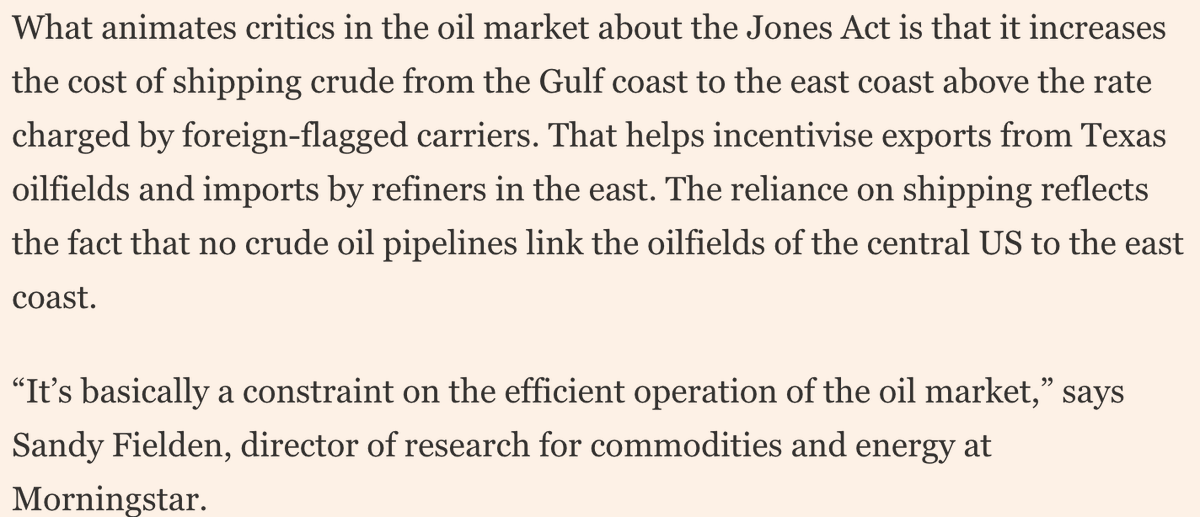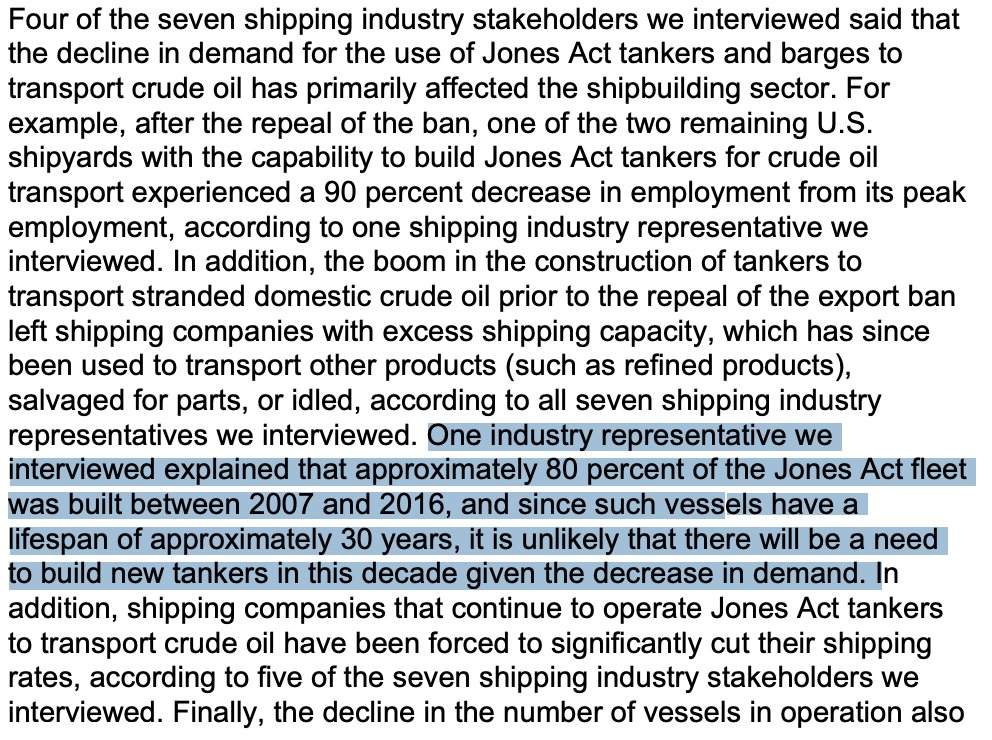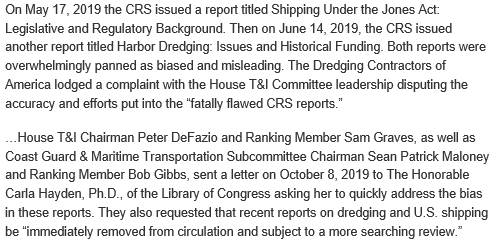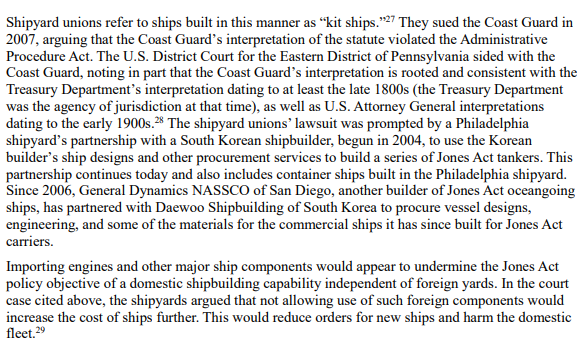
Per @JoshuaSteinman's suggestion, here's a 🧵 about the Jones Act. The term "Jones Act" typically refers to Section 27 of the 1920 Merchant Marine Act, which restricts domestic waterborne transport of goods to vessels that are US-flagged, built, & at least 75% US-owned & crewed.
Background: US maritime protectionism didn't begin in 1920. When Congress passed the 1789 Tariff Act among its provisions were discriminatory duties on shipping. Foreign ships could transport goods between US ports but were subject to much heavier duties than US vessels.
In 1817 An Act Concerning the Navigation of the United States was passed restricting domestic waterborne transport to US-flagged ships. And to be US-flagged, ships had to be US-built (as well as crewed and owned, I believe). The JA is a direct descendent of this law.
These restrictions were designed to avoid reliance on foreign (particularly British) shipping and promote private US shipping, which in wartime could be used to hunt enemy vessels: history.com/news/american-… usni.org/magazines/nava…
Privateers, of course, are no more. Another key difference: back then, US shipping and shipbuilding were some of the world's best. So much so that some have argued these shipping restrictions were essentially cost-free. Excerpt from The Abandoned Ocean: amazon.com/Abandoned-Ocea… 

Also see here:
https://twitter.com/cpgrabow/status/1469350604266954753
So what was the point of the 1920 Jones Act if the United States already had domestic shipping restrictions in place?
Well, as the decades passed and ship construction moved from wood and sail to iron and steam, protected U.S. shipyards fell behind.
Well, as the decades passed and ship construction moved from wood and sail to iron and steam, protected U.S. shipyards fell behind.
This 1894 report, for example, states (pg. xxiv) that U.S. shipyard costs were 25-35% higher than those of U.K. shipyards: drive.google.com/file/d/1Cl5FDb…
Ironically, this was partially due to protectionism for other industries that increased the cost of shipbuilding inputs.
Ironically, this was partially due to protectionism for other industries that increased the cost of shipbuilding inputs.
U.S. shipping went from some of the world's most efficient to uncompetitive (see excerpt from 1904 hearing), and people started looking for ways to avoid it. Alaskans did so by shipping goods to the Lower 48 through Vancouver, allowing them to utilize cheaper foreign ships. 

Seattle-based shipping companies hated that as they wanted the AK trade to themselves. So they lobbied Sen. Wesley Jones (R-WA) to block this foreign competition, which he did by inserting Section 27 into the Merchant Marine Act of 1920.
Can read more about this here:
https://twitter.com/cpgrabow/status/1273249081645768709and here: grassrootinstitute.org/2021/11/new-re…
So that's how we got the Jones Act. It's an old law from a far different time. Next question: is the law working?
JA supporters typically claim the law achieves three things: promotes shipbuilding (U.S.-built requirement) as well as ships (U.S.-flagged requirement) and a pool of mariners (U.S.-crewed requirement) that can be used to meet wartime sealift needs.
The problem here is that U.S. ships are 3x more expensive to operate and 4-5x more expensive to build than foreign ships. As one shipowner said during a 1904 hearing of the Merchant Marine Commission "We are operating an expensive ship expensively." 

Since Jones Act shipping is so expensive, there is little demand for it (typically only used when there is no alternative, such as sending something to Hawaii). The result is a fleet that now numbers less than 100 ships. 







Fewer ships mean fewer mariners to crew them, and a 2017 government report found a deficit of mariners needed to conduct a sustained sealift campaign: maritime.dot.gov/sites/marad.do… 

As for shipbuilding, little demand for JA shipping means that few ships get built. Since 2000 JA ships deliveries have averaged about 3 per year. And it's trending down. In 2019 only 2 ships were delivered. Last year just one. So far this year, zero.
So why is U.S. commercial shipbuilding so uncompetitive? Let's first dispense with some of the usual explanations. It isn't because U.S. shipbuilding wages are so high: nassco.com/pdfs/Shipbuild…
Also see:
Also see:
https://twitter.com/cpgrabow/status/142876486671468134

The role of foreign subsidies is non-trivial but probably also overstated. See:
https://twitter.com/cpgrabow/status/1172574554956455938
Remember folks, U.S. shipbuilding was uncompetitive long before subsidized Chinese and South Korean shipyards entered the scene. And U.S. shipyards can't compete with high-wage yards in Europe.
U.S. shipbuilding was uncompetitive even when the U.S. was handing out generous construction differential subsidies (up to 50% of the cost of the ship) that weren't ended until the early 1980s. Note for example this 1979 @baltimoresun article: drive.google.com/file/d/1UJwLSB…
The reality is that U.S. shipyards are inferior in numerous ways as I showed in this 2019 policy analysis: cato.org/policy-analysi… 



The Jones Act is complicit in this lack of competitiveness. It means, for example, reduced specialization as shipbuilders build a variety of vessel types for a captive domestic market. See here:
https://twitter.com/cpgrabow/status/1428764866714681347
The Jones Act also means reduced opportunities for outsourcing as is practiced by European shipyards (see here:
https://twitter.com/cpgrabow/status/1370106112586965008) as JA ships must be entirely assembled in the U.S.
And it means reduced scale. Series production helps keep costs low as fixed costs are spread and builders move up the learning curve. But the US is a small market for ships, so rarely more than two are ordered at a time. Foreign shipyards, meanwhile, might build a dozen or more.
The kicker is that not only is U.S. commercial shipbuilding shockingly uncompetitive, but it doesn't even grant the country shipbuilding self-sufficiency given its reliance on foreign designs and components: 



Heck, for all the talk one sometimes encounters about the JA being necessary to counter China, JA ships make use of Chinese state-owned shipyards for repair and maintenance: cato.org/blog/creaking-… 

That the U.S. still has several large shipyards is due less to the JA than government/military contracts that in 2019 accounted for nearly 80% of shipbuilding and repair revenue: maritime.dot.gov/sites/marad.do… 

And this isn't new:
https://twitter.com/cpgrabow/status/1455642600610877441
Lastly, in the conflicts of recent decades, JA ships have been rarely used for military sealift. Which makes sense. If ships are pulled from domestic trade, who will transport goods to AK, HI, Guam, Puerto Rico, etc.?
From a government report released last year: maritime.dot.gov/sites/marad.do…
Note the specific mention of ships from the international trades and nothing about the domestic (Jones Act) fleet.
Note the specific mention of ships from the international trades and nothing about the domestic (Jones Act) fleet.

To sum up, the JA is a total failure. Shipyards are horribly uncompetitive and their output small. The fleet is small and old (result of high replacement costs). Mariner numbers are insufficient. By every reasonable metric the law isn't working.
The Jones Act isn't a well-thought-out strategy. It's the result of lobbying and status quo bias. If the United States was to start maritime policy from scratch today, no one would come up with the JA as the answer.
Believe it or not, this insanely long (apologies) thread only scratches the surface. None of this even really touches on the law's economic costs. /FIN
• • •
Missing some Tweet in this thread? You can try to
force a refresh




















